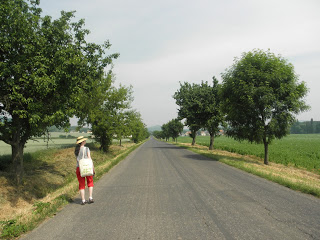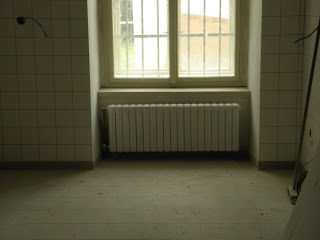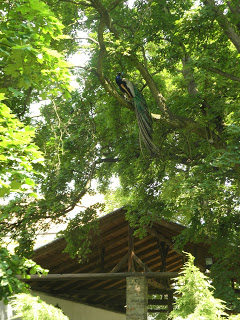Ploskovice—A White Jewel Full of Contrasts
Description: Beautiful, fairy-tale-like chateau with unusual history and interiors.
Themes: Chateau, chateau garden, colonnade, Baroque, artificial caves “grottas”, films, fairy-tales, peacocks.
Distance from a city: 100 km to the North from Prague.
It’s close to Děčín, Liberec and Ústí nad Labem, and a manageable distance from Plzeň. But if you live in Ostrava, Brno or České Budějovice, it’s virtually inaccessible unless you’re prepared to spend a night in Prague or 6–8 hours travelling there and back.
Transport, level of difficulty, orientation: There is a parking lot right next to the entrance gate to the chateau area. You can find a train or a coach at www.idos.cz, the journey from Prague takes about 1,5 hours. If you go by coach, it’s very easy—it stops right in front of the entrance gate.
If you go by train, you’ll need to change trains in Lovosice. Fortunately, that is very easy—the local train waits for the express from Prague. It’s usually painted yellow-orange-green and leaves from the 3rd platform. Follow the time when on the train, and about a minute before getting off in Ploskovice, have a look at the displays and if a sign saying “zastavíme” doesn’t appear, find a red button “zastávka na znamení” (=“request stop”), which is usually situated at all the inner doors, and press it. After getting off, stand facing the railway station in Ploskovice and take the road to the left. Be careful and keep really close to the left side of it, one after another, don’t form groups. The road is quite busy. After some 400 metres, you’ll reach a right turn, with an alley.
Take it and it will lead you straight to the village. Follow the signs saying “zámek” (unfortunately, they look totally different every time and sometimes they’re a bit hidden behind bushes)
until you see a pub. The entrance gate is further on, across the street from the pub.
Unfortunately, it looks like the regional administration is thinking about cancelling the Ploskovice train stop. There are protests against it, but who knows how it will end. Be sure to consult www.idos.cz before you set out.
If you use a coach or go by car, the trip is extremely easy. If you go by train, be prepared for some 4 or 5 km of walking (including the chateau and its park).
Time required: If you go from Prague, about 7 hours.
The guided tour of the chateau takes about 70 minutes, if you buy a ticket
to the grottas—artificial caves below the chateau. Which I recommend you
do. Then about 3 hours of walking, taking pictures, having
a lunch…
The journey by coach or train takes 1,5 hour there + 1,5 hour back. You can
leave at about 9 a.m. and return at 5-6 p.m.
Price: Journey from Prague + entrance fee + souvenirs = 300–400 CZK
Suitability for handicapped people: Very low. Except for those on wheelchairs, if they don’t mind missing the second floor, because there’s still a lot to see in the chateau garden, the artificial caves and the first floor that are accessible.
Suitability for children: Except the fact that there isn’t much walking, low. Unless your kids are interested in history or art. But if they’ve seen the chateau in a film, they might enjoy it—plus, the guided tours try to make the hour as interesting for kids as possible—for example, they ask them to play a clock-counting game (the emperor who lived here collected clocks). And there are various special events for kids regularly—see the chateau’s website.
Facilities: Toilets for free are in a detached building, close to the entrance gate to the area. For such a famous chateau, they aren’t exactly fancy, but they’re clean. And it looks like they’re being renovated, so who knows, perhaps they’ll be extremely fancy when you get there :-)
When we were in Ploskovice, there was no café in the chateau but now their
website says there is one. The ticket office only opens twice an hour for
5 minutes. There is a restaurant across the street from the entrance
gate, with good Czech meals for reasonable prices. The menu’s just in Czech,
though.
The ticket office staff are nice and helpful and you can buy various
souvenirs.
Languages: You’ll always get by with simple English. If you don’t want to spend too much money, go on a Czech-language tour and borrow the same text printed in a foreign language for 10 CZK. They also offer foreign language tours for twice the price.
Pronunciation, meaning: “Ploskovitseh”, and the name comes from the word “ploský”=“flat”.
Website: www.zamek-ploskovice.cz
𝔐y Latvian friend and me went to the chateau of Ploskovice yesterday. She’d wanted to go there for 5 years! So I was really scared that it won’t be as perfect as she’d expected. But it was!
Ploskovice isn’t an easy topic because sooo much about this chateau is
beautiful, unusual or interesting. So it’s hard to choose what to focus
on.
Well… what about telling you about the ONE thing that ISN’T
unusual about it :-) It’s the chateau garden. It’s nice
but—yeah, that’s it.
Now for the unusual stuff:
Let’s take the peacocks first. Why peacocks, you ask? Because many
Czech chateaus keep peacocks in their gardens—as a reminder that local
aristocrats kept them—and Ploskovice is no exception. But it IS an
exception as to the high number of the peacocks. And that day, also as to the
way they behaved.
There was a wedding taking place, and the wedding guests were asked to shout
out several times. I don’t know why—perhaps for some photos. And every
time they shouted, the peacocks started to screech, too!
Also, they had obviously decided to show themselves to us in all various positions and situations:
And that isn’t where the unusual stuff ends. If you notice the layout of the area, you realize it’s a Christian cross. I don’t think that was the intention, but it somehow came out that the chateau is the short horizontal line, and crossing it is a long vertical line that is a water-pipe system. You can’t see all of it, as it’s under the ground, and some of the fountains or ponds have been converted into something else. Like this one—into a flower-bed:
But there really is a water-pipe system, starting with this fountain:
then going below the chateau through the artificial caves in the cellar, making for its damp air. The Italian countess that had the chateau built wanted such caves, because she intended to use Ploskovice as a summer residence. She liked the “grottas” she knew from her home country. They seem a bit out of place here, though, because the CzR isn’t as warm as Italy. But the day we visited Ploskovice was extremely hot, so we were grateful to the countess :-)
The iron gate below the chateau is the entrance to the grottas.
Then there is another fountain:
and the whole system ends with a pond.
Remember the contrasts I mentioned in the name of this article? Oh, there’s lots of them. Here we go:
First, the countryside Ploskovice is situated in. It’s a geographic
region called “České středohoří” (which means “Bohemian
Central-Mountainous-Area”). It takes up a big part of the region north of
Prague. It looks like lowlands with fields, with the occassional
mountain sticking out of them. They used to be volcanoes (inactive now)
and some of them still have the “caps” on top reminding us that these
mountains came to be when something decided to come out from the middle
of the Earth.
You can see one of these mountains with “caps” in the background here:
I’m used to lowlands, highlands and mountains, so this countryside still seems very unusual to me. But imagine—to live in a lowland where you can climb a mountain and have a wonderful view of the country below, whenever you feel like it—isn’t that grand?
Also, the fact that an Austrian emperor lived there and a Hollywood film was filmed there—but when you arrive by train, it looks like you arrived in the Land of Nobody. The railway station looks exactly what I remember railway stations looked like in the 1980’s, and there’s almost nothing to be seen far and wide.
Then, the chateau itself and its architecture. But perhaps it’s better if I just show you the pictures. Suffice it to say that no other chateau in the CzR looks similar to Ploskovice. And that it was built in 1680’s. The Baroque style. The shape of the chateau is a simple cube
but the details are full of curves and emotions.
Another contrast is the interior. Judging by the exterior—with its statues with dramatic expressions—you’d guess that the interior would be dramatic, too. Well, it’s not. Much of the furniture is the exact opposite—simple, white, cozy, geometric Classicism.
But there still are some very unusual objects inside. I made notes of them:
- a chandelier that weighs 30 kg
- a 1810 wastebasket
- portraits of the 18th century Europe’s ugliest married couple
- a fake aquarium
- a fine china teapot that’s made to look like it’s made of wood, and a wooden chandelier that’s made to look like it’s made of fine china
- perfume bottles that held perfume made of cinnamon. I can’t imagine smelling like cinnamon—I’d be afraid somebody would eat me!
- a toilet made to look like two large books
- a picture of the coronation ceremony of an Austrian emperor, where they ate huge cakes made into shapes of various specific castles
- a clock on the ceiling that goes anti-clock-wise. You can see it in a mirror on the floor (where it apparently goes clock-wise)
But I personally think the most extreme and unusual thing about Ploskovice is its history. Listen:
In 12th centrury, there was a fortress that belonged to an order of knights in Prague. It being 100 kilometres from Prague (which was a 3-day journey then), the order took no interest in it. They would mortgage it every time they needed money—and then they lost it when they couldn’t pay the mortgage, so the place changed hands frequently.
One of its infamous owners was Adam Ploskovský, who was notorious for his cruelty towards the village folk. There was an uprising against him in 1496 and the villagers nearly killed him. They chose another aristocrat to work for. His name was Dalibor of Kozojedy (“village where they eat goats”), but he was executed for stealing from his brother. Funny thing is, the stuff he was supposed to have stolen was cattle… a cattle eater indeed! If you’re familiar with Prague, there’s a tower where he was imprisoned before execution, and it’s named after him. It’s right behind the Prague Castle and it’s called “Daliborka”. By the way, he became famous and was idealized in the 19th century, and Bedřich Smetana, a Czech composer, wrote an opera about him.
In the 17th century, Ploskovice got lucky and started its journey to fame.
An Italian countess and her German husband bought it. He lived in Germany
mostly, while she thought Ploskovice might be a nice place for a summer
residence. So she built it in a style that would remind her of Italy—and
then burned all the invoices and bills and documents and everything, so that
her husband wouldn’t know exactly what it cost her! There were no bank
accounts then for him to know how much exactly she took from it.
Unfortunately, this means that we don’t know who built the chateau, or where
the materials came from, etc. etc. Historians can only guess. They like that
sort of work.
Then Ploskovice changed hands frequently again, and the owners were more and more high-up in the society. Finally, the emperor himself used it… to die.
His name was Ferdinand, it was in the 1848 and he abdicated due to poor health and retired to Ploskovice. He gave his throne to Franz Joseph I. (uncle of Franz Ferdinand d’Este who I told you about in Konopiště), saying: “The most important thing is: be nice!”
You can see many details in Ploskovice that will remind you that it was sort of an emperor’s hospital. It has no thresholds, for example, so that the bed with the emperor (which has cylinders attached to it) could be rolled through any door to the top of the arcades, where the emperor would enjoy the fresh air and view of the countryside.
Guess what the chateau was when Czechoslovakia became an independent republic
in 1918?
A summer residence for diplomats.
And guess what it was during the Second World War?
A school for young Nazis and a shooting range. They painted all walls white
(their favourite colour, obviously).
Later, it became popular in the film industry, because… let’s face it, it’s extremely photogenic. Some people wait 20 years to be discovered as actors, Mrs. Ploskovice waited 300… but she made it!
She acted in the Oscar-winning Amadeus, the Three Musketeers series by BBC, and numerous video clips and Czech fairy-tales.
Princ a Večernice (1978), starring Libuše Šafránková, Juraj Ďurdiak and Ploskovice
So you see: Prague knights, angry villagers, Italian countess, a dying emperor, diplomats, young Nazis, a Czech opera, a BBC series and a Hollywood film… Ploskovice certainly is a lady with a colourful past!
But now she’s simply a history lesson and a wedding host. I think that’s for the best. Lots of children and young people visit her, and she can have some fun, as well as peace and quiet. No extremes and contrasts anymore.
But for us, the contrasts didn’t end with this… The weather was nice and windless all the time. But when I got home, my father who follows a special railway website told me that about 30 minutes after we left, a storm came there and a tree fell on the tracks! Thank God we left in time!
- Log in to post comments
























